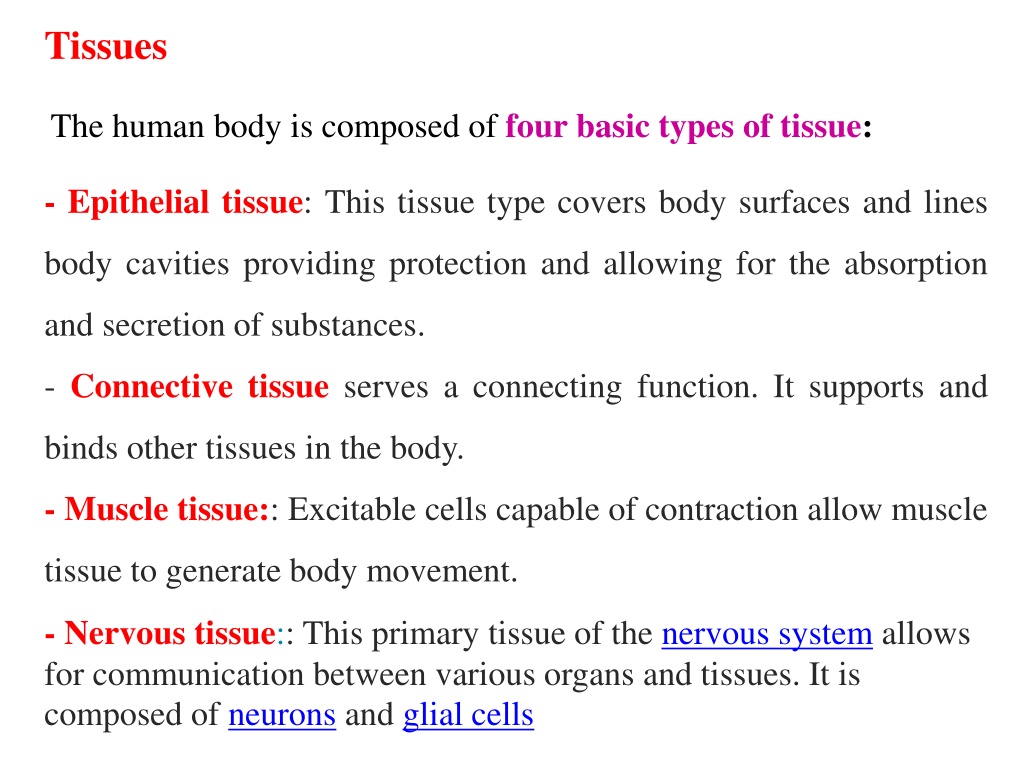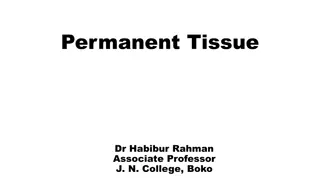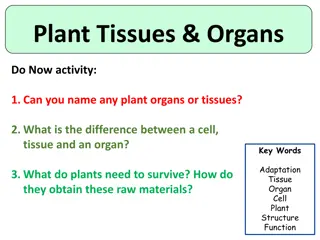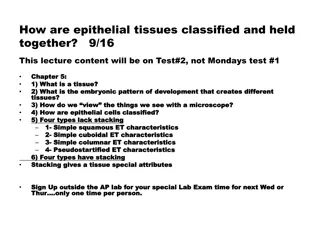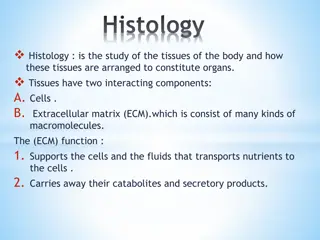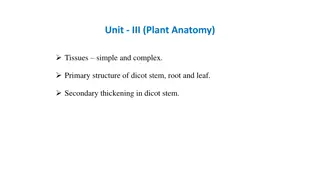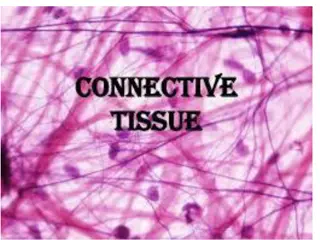Understanding Epithelial Tissues: Structure and Function
Epithelial tissues play crucial roles in the human body, covering surfaces, lining cavities, and forming glands. They are highly cellular and rest on a basement membrane, separating them from connective tissues. Epithelial tissues serve functions such as protection, absorption, secretion, and contractility. These tissues can be categorized into covering (or lining) epithelia and glandular epithelia, based on their structure and organization. Simple epithelia, with single layers of cells, are essential for processes like absorption and filtration. Examples include simple squamous epithelium found in areas allowing passive diffusion of gases and simple cuboidal epithelium with secretory or absorptive functions.
Download Presentation

Please find below an Image/Link to download the presentation.
The content on the website is provided AS IS for your information and personal use only. It may not be sold, licensed, or shared on other websites without obtaining consent from the author. Download presentation by click this link. If you encounter any issues during the download, it is possible that the publisher has removed the file from their server.
E N D
Presentation Transcript
Tissues The human body is composed of four basic types of tissue: - Epithelial tissue: This tissue type covers body surfaces and lines body cavities providing protection and allowing for the absorption and secretion of substances. - Connective tissue serves a connecting function. It supports and binds other tissues in the body. - Muscle tissue:: Excitable cells capable of contraction allow muscle tissue to generate body movement. - Nervous tissue:: This primary tissue of the nervous system allows for communication between various organs and tissues. It is composed of neurons and glial cells
Epithelial tissue Epithelial tissue is one of the four basic tissue types composed of diverse morphologic and functional subtypes that cover body surfaces, line body cavities, and form glands. The unique feature of the epithelial tissues is its highly cellular composition with little extracellular matrix (ECM). Epithelial tissues rest on top of the basement membrane, which separates epithelia from underlying connective tissues. epithelial cell basement membrane
The principal functions of epithelial tissues are: Covering, lining, and protecting surfaces (eg, skin). Absorption (eg, the intestines). Secretion (eg, the epithelial cells of glands). Contractility (eg, myoepithelial cells).
Epithelial tissue types Epithelia tissues can be divided into two main groups according to their structure and function: covering (or lining) epithelia and glandular epithelia. (1) Covering or Lining Epithelia are tissues in which the cells are organized in layers that cover the external surface or line the cavities of the body. They are classified according to the number of cell layers: simple epithelia contain only one layer of cells stratified epithelia contain more than one layer.
A- Simple epithelium Is a single layer of cells with every cell in direct contact with the basement membrane that separates it from the underlying connective tissue. It is found where absorption and filtration occur. The thinness of the epithelial barrier facilitates these processes. Simple epithelial tissues are classified by the shape of their cell into four major classes:
1- Simple squamous: which is found lining areas where passive diffusion of gases occur. Skin, walls of capillaries and peritoneal cavities, as well as the linings of the alveoli of the lungs 2- Simple cuboidal : these cells may have secretory, absorptive, or excretory functions. Examples include small collecting ducts of kidney, pancreas, and salivary gland.
3- Simple columnar: cells can be secretory, absorptive, or excretory, can be ciliated or non-ciliated; ciliated columnar is found in the female reproductive tract and uterus. Non-ciliated epithelium can also possess microvilli. 4-Pseudo stratified can be ciliated or non-ciliated. The ciliated type is also called respiratory epithelium. Protection, secretion
B- Stratified epithelium Stratified epithelium differs from simple epithelium in that it is multilayered. Stratified epithelia are classified according to the cell shape of the superficial layers: 1. Stratified squamous - Stratified squamous keratinized epithelium (rich in keratin intermediate filaments), epidermis of skin - Stratified squamous non keratinized epithelium (with sparse amounts of keratin).lines wet cavities eg, mouth, esophagus.
2- Stratified cuboidalepithelium is restricted to large excretory ducts of sweat and salivary glands, where it provides a lining more robust than that of a simple epithelium. 3- Stratified columnar epithelia are rare, can be found in the lining the eyelids, where it is both protective and secreting. ..
4-Transitional epithelium or urothelium: lines urinary bladder, ureter, and the upper part of the urethra, is characterized by a superficial layer of domelike cells that are neither squamous nor columnar. These cells called umbrella cells, are essentially protective against the hypertonic and potentially cytotoxic effects of urine..
2- Glandular Epithelia Is the type of epithelium that forms the glands . Glandular epithelia are formed by cells specialized to secrete. The molecules to be secreted are stored in the cells in small membrane-bound vesicles called secretory granules. The epithelia that form glands can be classified according to various criteria. Unicellular glands consist of large isolated secretory cells( goblet cell in the lining of the small intestine or respiratory tract). multicellular glands have clusters of cells.
There are two major classifications of glands: endocrine glands and exocrine glands: Endocrine glands have lost their connection to the surface from which they originated during development. These glands are therefore ductless and their secretions are picked up and transported to their sites of action by the bloodstream . Exocrine glands retain their connection with the surface epithelium, the connection taking the form of tubular ducts lined with epithelial cells through which the secretions pass to the surface. Exocrine glands have a secretory portion, which contains the cells specialized for secretion, and ducts, which transport the secretion out of the gland.
The morphology of these components allows the glands to be classified according to the scheme Simple gland : Ducts can be simple (un branched) 1. Simple tubular, mucous secretion, ex. small and large intestine. 2. Simple branched tubular, mostly mucous secretion, ex. stomach pylorus. 3. Simple coiled tubular, sweat secretion, ex. skin sweat glands. 4. Simple acinar, mucous secretion, ex. glands near penile urethra. 5. Simple branched acinar, sebum secretion, skin sebaceous glands.
Compound glands Ductwith two or more branches Compound tubular, mucous secretion, Brunner glands of duodenum 1. Compound acinar, watery protein - aceous secretion, Parotid glands, pancreas, 2. and mammary glands. Compound tubuloacinar. Mucous and serous secretion Submandibular and 3. sublingual salivary glands.
